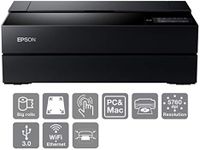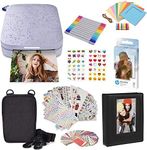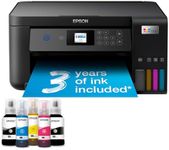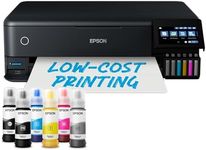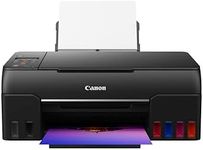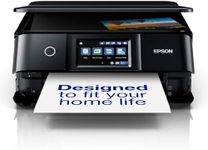Buying Guide for the Best Printer For Photos
Choosing the right printer for photos involves understanding the key specifications that will affect the quality and efficiency of your prints. It's important to consider what you will be using the printer for, how often you will be printing, and the level of detail you require in your photos. By focusing on the following key specifications, you can find a printer that best fits your needs and ensures your photos come out looking their best.Print ResolutionPrint resolution is measured in dots per inch (DPI) and indicates how many dots of ink the printer can place on a square inch of paper. Higher DPI means more detail and sharper images. For high-quality photo prints, look for a printer with at least 1200 DPI. If you need professional-grade prints, consider printers with 2400 DPI or higher. Your choice should depend on how detailed and crisp you want your photos to be.
Ink TypesPrinters use different types of ink, such as dye-based or pigment-based. Dye-based inks are known for their vibrant colors and are great for glossy photo prints. Pigment-based inks are more durable and resistant to fading, making them ideal for archival-quality prints. Consider what is more important for you: vibrant colors or longevity of the prints. If you want your photos to last a long time without fading, go for pigment-based inks.
Color GamutColor gamut refers to the range of colors a printer can produce. A wider color gamut means the printer can reproduce more colors, resulting in more accurate and vibrant photos. Look for printers that offer a wide color gamut, especially if you are printing photos with a lot of color variation. This is particularly important for professional photographers who need precise color reproduction.
Print SizeConsider the maximum print size the printer can handle. Standard photo printers typically print up to 8.5 x 11 inches, but if you need larger prints, look for wide-format printers that can handle sizes like 13 x 19 inches or even larger. Think about the typical size of the photos you want to print and choose a printer that can accommodate those dimensions.
Paper CompatibilityDifferent printers support different types of photo paper, such as glossy, matte, or fine art paper. Make sure the printer you choose is compatible with the type of paper you prefer to use. This will ensure the best print quality and longevity of your photos. If you plan to experiment with various paper types, look for a printer with versatile paper handling capabilities.
Connectivity OptionsModern photo printers offer various connectivity options like USB, Wi-Fi, Bluetooth, and memory card slots. Wi-Fi and Bluetooth allow for wireless printing from your smartphone or computer, which can be very convenient. Consider how you plan to connect to the printer and choose one that offers the connectivity options that best suit your workflow.
Print SpeedPrint speed is measured in pages per minute (PPM) and indicates how quickly the printer can produce prints. While high print speed is not as crucial for photo printing as it is for document printing, it can still be a factor if you need to print large volumes of photos. If you print frequently or in large batches, look for a printer with a higher PPM to save time.
Cost of ConsumablesConsider the cost of ink cartridges and photo paper, as these can add up over time. Some printers have more affordable consumables, while others may be more expensive to maintain. Look for printers with high-yield ink cartridges or consider third-party ink options if they are compatible. Think about your printing frequency and budget for consumables accordingly.


